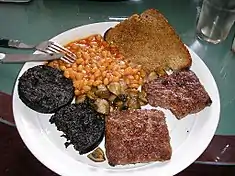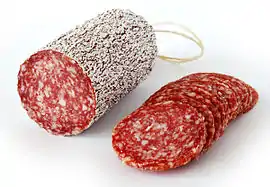Lorne sausage
The Lorne sausage, also known as square sausage, slicey or flat, is a traditional Scottish food item made from minced meat, rusk and spices.[1] Although termed a sausage no casing is used to hold the meat in shape, hence it is usually served as square-shaped slices from a formed block. It is a common component of the traditional Scottish breakfast.

Name
It is thought that the sausage is named after the region of Lorne in Argyll;[2] advertisements for 'Lorne Sausage' have been found in newspapers as early as 1896.[3][4] This was long before comedian Tommy Lorne, after whom the sausage has been said to be named, became well-known.[5]
History
The exact origins of the Lorne sausage remain unclear. It is often eaten in the Scottish variant of the full breakfast or in a breakfast roll. The sausage is also an appropriate size to make a sandwich using a slice from a plain loaf of bread cut in half.[2]
Preparation
Sausage meat, in this case a mixture of pork and beef, is minced with rusk and spices, packed into a rectangular tin with a cross-section of about 10 centimetres (3.9 in) square, and sliced about 1 centimetre (0.39 in) thick before cooking.[6] Square sausage has no casing, unlike traditional sausages, and must be tightly packed into the mould to hold it together; slices are often not truly square.[2]
See also
References
- "A history of the square sausage, including a recipe for making your own - Scotsman Food & Drink". Scotsman Food & Drink. 2016-03-10. Retrieved 2016-11-05.
- "Lorne Sausage, Argyll". Information Britain. Retrieved 14 December 2013.
- "Scotslanguage.com - Lorne sausage n. square-shaped sausage meat".
- Archive, The British Newspaper. "Results - Arbroath Herald and Advertiser For The Montrose Burghs - Publication - British Newspaper Archive". www.britishnewspaperarchive.co.uk.
- "Lorne Sausage Scottish Square Slices Sausages". www.aboutaberdeen.com.
- "Lorne Sausage". Dictionary of the Scots Language. Archived from the original on 14 December 2013. Retrieved 14 December 2013.
